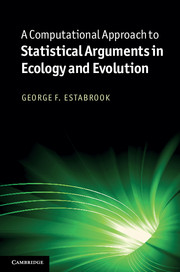Book contents
- Frontmatter
- Contents
- Acknowledgments
- 1 Introduction
- 2 Programming and statistical concepts
- 3 Choosing a test statistic
- 4 Random variables and distributions
- 5 More programming and statistical concepts
- 6 Parametric distributions
- 7 Linear model
- 8 Fitting distributions
- 9 Dependencies
- 10 How to get away with peeking at data
- 11 Contingency
- References
- Index
4 - Random variables and distributions
Published online by Cambridge University Press: 05 June 2012
- Frontmatter
- Contents
- Acknowledgments
- 1 Introduction
- 2 Programming and statistical concepts
- 3 Choosing a test statistic
- 4 Random variables and distributions
- 5 More programming and statistical concepts
- 6 Parametric distributions
- 7 Linear model
- 8 Fitting distributions
- 9 Dependencies
- 10 How to get away with peeking at data
- 11 Contingency
- References
- Index
Summary
At random
We use the term, at random, in everyday speech, where it has a vague, intuitive meaning, but in order to use the term, at random, to make statistical arguments explicit, it must be clearly defined. There are philosophical debates and different schools of thought to define what, at random, should mean, especially as it applies to natural phenomena whose behavior we cannot predict with much precision from known deterministic causes. Although we may not be able to predict measurable values with much precision, usually there are some constraints and some patterns. If some quantitative aspect of a phenomenon is observed many different times, its values may tend to fall in a given range with an approximate frequency. One school of thought, called the frequentists, define the term, at random, in this way: something observed under specified natural conditions varies at random if, when large numbers of values are observed independently, they tend to fall in specified ranges with consistent frequencies. I will not discuss other schools of thought here, but for purposes of reading this text, you can consider yourself a frequentist.
The frequentist concept can be idealized to enable us to say, in some cases, what we think those frequencies should be. For example, flipping a coin results in two possible observations: heads or tails. We say that the coin is fair if the frequency of each of those two values is approximately 1/2 when the coin is flipped independently a large number of times. For our purposes generally, the words, observations are made independently, mean that if we observe the value of a flip, it does not affect the frequencies of the values of subsequent flips. More generally, “observations are made independently” means that if we know the observed value of an instance of a random process, then it does not change the frequencies with which possible values will be observed in a subsequent instance.
- Type
- Chapter
- Information
- Publisher: Cambridge University PressPrint publication year: 2011

